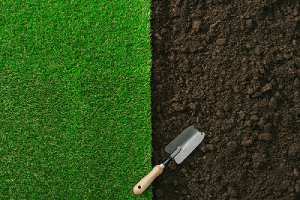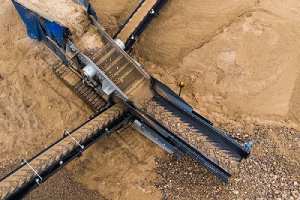 Dirt. Love it or hate it, dirt is extremely important for human lives. Farmers use dirt to grow nutritious crops, contractors rely on dirt to build solid foundations, and entire industries have popped up based on providing, transporting, and disposing of dirt.
Dirt. Love it or hate it, dirt is extremely important for human lives. Farmers use dirt to grow nutritious crops, contractors rely on dirt to build solid foundations, and entire industries have popped up based on providing, transporting, and disposing of dirt.
To the untrained eye, all dirt might seem the same; gross, dusty, and creates mud when wet. However, in order for dirt to do its job, you need to make sure you have the right kind of dirt for your project.
Fill Dirt Vs. Topsoil Dirt
One kind of dirt is fill dirt. Fill dirt is different than your everyday dirt on the ground which is usually called topsoil dirt. Topsoil dirt is the uppermost layer of dirt that contains the nutrients and minerals that plants need to grow and thrive. So topsoil is the ideal dirt choice if you are planting trees, flowers, and shrubs.
In contrast, fill dirt is the bottom layer of dirt under the topsoil. Fill dirt does not contain organic nutrients and is normally made from broken and compressed bits of rocks, clay, and sand. The purpose of fill dirt is to provide stability to construction on a given plot of land. Fill dirt is uniquely suited to this task as, unlike topsoil, fill dirt has much less void space— the space between dirt particles.
Picture it this way; say you tried to build a house on top of topsoil alone. Since topsoil is loose and relatively non-compact, it will shift under the weight of the house. This can cause massive foundational damage and completely destroy the structural integrity of your house over time. Topsoil is also much more permeable to water which can cause flooding and wood rot.
Fill dirt will not shift and change shape under the weight of your house, so it is better suited for building a foundation on top of. Fill dirt also is packed tightly enough so water does not seep in, which prevents long-term water damage.
Fill Dirt Uses
Landscaping
 Landscaping does involve a lot of topsoils, but the main construction process of landscaping primarily uses fill dirt. Since fill dirt is stable and compact, it is used to create the main landscape elements like rides, mounds, and dips. Fill dirt is strategically placed to create multilevel landscapes that can last through all kinds of weather for long periods.
Landscaping does involve a lot of topsoils, but the main construction process of landscaping primarily uses fill dirt. Since fill dirt is stable and compact, it is used to create the main landscape elements like rides, mounds, and dips. Fill dirt is strategically placed to create multilevel landscapes that can last through all kinds of weather for long periods.
Construction
Perhaps the most common use of fill dirt is for construction. Fill dirt is used by construction companies to create the foundation for building projects. No building can be safe if it does not rest on solid foundations, so contractors in many states are required by law to use fill dirt that meets certain standards for density and compactness.
Septic systems and other underground fixtures
Fill dirt is also used to surround underground systems like septic tanks and pipes to prevent the earth from shifting around them. If you have ever been around a busted septic tank, you know how bad it can be. Properly packed fill dirt preserves the integrity of such underground systems and makes them reliable.
Types of Fill Dirt
Fill Sand
Fill sand is commonly considered a kind of fill dirt, even though, technically, sand is not dirt. Sand is made from tiny silica (rock) particles and is often an ingredient of fill dirt, but is distinct.
Since fill sand contains small granular pieces of rock, it is excellent for draining moisture. As such, fill sand is often used for landscaping in areas that get a lot of water. The sand under the layer of the topsoil absorbs excess water, which prevents flooding and mud formation. However, fill sand can shift under large weights so it is not suitable for building foundations. Fill sand can also draw moisture into house foundations which can ruin wood and metal.
Clay
Clay fill dirt is fill dirt that contains more than 50% clay. Clay is excellent for foundations as it is sturdy, has very little void space, and is resistant to water absorption. Class fill dirt is often used as a base for roads, pathways, buildings, and other structures, Properly filled clay foundations can be as stable as stone.
However, clay fill dirt should be avoided for planting areas. While clay is important for topsoil to retain its nutrient value and help plants grow, too much clay prevents proper water drainage.
Screened/ unscreened dirt
 Screened fill dirt is fill dirt that has been screened to remove rocks, roots, and other large particles. Screened dirt is passed through a filter that takes out bigger pieces. Screened dirt is usually more expensive because of the labor it takes to produce, but is usually better quality and more stable than unscreened dirt as it has less void space. Screening also makes the dirt easier to work with by breaking up large chunks into a more uniform consistency.
Screened fill dirt is fill dirt that has been screened to remove rocks, roots, and other large particles. Screened dirt is passed through a filter that takes out bigger pieces. Screened dirt is usually more expensive because of the labor it takes to produce, but is usually better quality and more stable than unscreened dirt as it has less void space. Screening also makes the dirt easier to work with by breaking up large chunks into a more uniform consistency.
Unscreened dirt, as the name implies, has not been screened to remove larger particles. Unscreened dirt is usually cheaper, but is lower quality and may not be suitable for some purposes.
Rock fill
Rock fill is another fill dirt that is technically not dirt. Rock fill contains big rocks, usually the size of a soccer ball, and is used to fill large holes. Gravel fill is a type of rock fill that contains smaller pebble-sized rocks. Rock fills are used for landscaping or industrial sites because it is sturdy, easy to work with, and not as difficult to move as clay fill dirt.
If you are planning a landscaping or construction project, it is imperative that you have the right kind of dirt. If you use the wrong kind of dirt, your project could lose its structural integrity or get damaged from moisture.
That is also why it is important to work with a reliable dirt provider. Dirt Connections provides professional dirt services to construction sites and property managers. Our team has over 30 years of experience in residential and commercial projects and can handle any job that is needed.











































